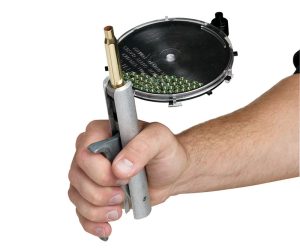Loading Ammo
After re-sizing your brass, make sure all lube is off the cases and its time to insert the primer. On the rifle we shared in the previous episode, we used our Super Six. This takes a small rifle primer. Some reloading presses can be used to seat the primer fully, another way, like I do, is using a hand primer. I use this one from RCBS.
from RCBS.
Once the primer is done, make sure you are using the correct powder and the correct amount of powder. I always double check my loads HERE with Hodgdon Reloading Center online. It’s imperative to use a rifle powder for rifle, a pistol powder for pistol, these are not interchangeable. This can get someone hurt or killed if you use the wrong powder. I am not trying to scare anyone, its just very important to always focus on what you are doing while reloading.
Once the powder is chosen and the correct amount, always weigh it to verify the right weight is used. Sometimes one grain of powder can be too much pressure in a cartridge, so please, never guess.
After powder, comes the bullet. Again, safety first, make sure you are using the right diameter bullet. 22cal, .243, .264, .277, etc… For our Super Six, its a .243 caliber bullet. I like the 65gr Vmax or the 70gr Ballistic tip from Nosler.
While you are checking for powder and powder charge, look at the same graphic and notice the maximum overall length or complete overall length. This is where you set your seating die, screw the die downward until you get the desired depth. Most AR15 cartridges are 2.250-2.260. Most of the AR10 type cartridges are in the 2.80” range, but always double check this.
Once you’re 100% sure that your loads are done by the book, it’s time to go to the range and check them. I always run my loads through a chronograph and do load development, we’ll talk about that in our next chapter.
